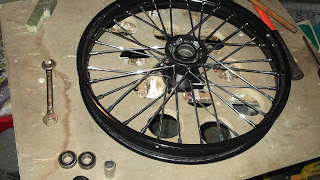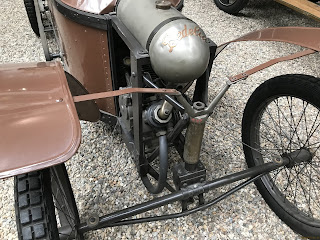The Bédélia, like the Automobilette, which was based on it (above), had a very unusual front axle arrangement, with two pivots, one which allowed it to pass, almost independently, over obstacles, and the other, which turned the entire axle for steering, with the turn activated with cables - a system called wire and bobbin. I can imagine the amount of tyre scuff! But apparently the vehicle's length meant that actually it was a very stable system, and as the car was successful in pre-WW1 racing, presumably it worked well. Suspension was at the centre of the axle, with the bottom bracket flexing like a swinging arm, and the upper stays being rigid (or so I am guessing, because frankly, there is little information that I have been able to find).
However, keen as I am to build a faithful caricature of the original, I think I will be asking for trouble if I replicate that complicated articulating system, and as my wheelbase is going to be a lot shorter, I shall avoid a lot of heartache by making my steering more conventional by following the Ackerman rules, so that the wheels steer at the ends of the cross tube, on stub axles.
I was going to have quarter elliptical suspension springs protruding from the chassis, but this was going to make the car very unlike its original at the nose, and that bothered me... until I saw some experiments that Rhys Nolan has been doing, inspired by the suspension on a very successful cyclekart built in the USA by Dave Dupaquier, the Maserati 250F.
Rhys' experiment is designed to see if Dupaquier's design can be done without welding
Ordinarily on cyclekarts, the axle is suspended (rides on springs) with the wheel mounted on a stub axle, which rotates inside a yoke on the ends of the axle.
 |
typical arrangement
|
But what is particularly clever in Rhys' version is that the yoke has been extended to accommodate two springs, the strongest on top, against which the car bounces, with the lower spring cushioning the unloading of the top spring. The kingpin, in this case an M16 bolt, passes through the spindle of the stub axle, so that the whole caboodle rides up and down it, providing the car with independent suspension at the front. The lower spring is something that Rhys has added to the system which Dave Dupaquier devised.
Dave's idea reverses the spindle yoke arrangement, putting the C-bracket/yoke at the end of the axle and the spindle tube on the end of the spindle, as on a go-kart stub axle, but with the centre of the spindle tube rising and descending on the kingpin. This is not a new idea but it is very seldom seen. Anyone with experience of Morgans will recognise it as a sliding pillar suspension system, but it was first seen in 1898, with this a 1908 version on a Sizaire-Naudin. In this case the head of the kingpin butted the end of a transverse leaf spring.
 |
Sizaire-Naudin of 1908 (Wiki: Buch-t)
|
 |
Dave Dupaquier's gorgeous Maserati 250F
|
 |
| Dave's elegantly executed sliding pillar suspension |
What makes this so exciting for me is that it provides a very simple, elegant and discreet arrangement which will make it possible to put Ackerman steering and suspension on my Bédélia cyclekart without severely compromising its aesthetics.
I have asked Gemini Karts if they'd be able to re-arrange their axle components like this. They are willing to, once they are less busy, which makes me wonder if I should try to do so myself, for now anyway.
So this evening I have been in the workshop fabricating a prototype using rectangular section steel tube, cut longitudinally, with top and bottom of the yoke right-angles cut from the same section, cut cross-ways. Both ends will be chain-drilled and welded, with M16 bolts for kingpins and M16 washers to tidy the holes.
 |
| Three bits, rough-cut + top spring |
A work in progress.




.jpg)





















.jpg)
.jpg)
.jpg)


















